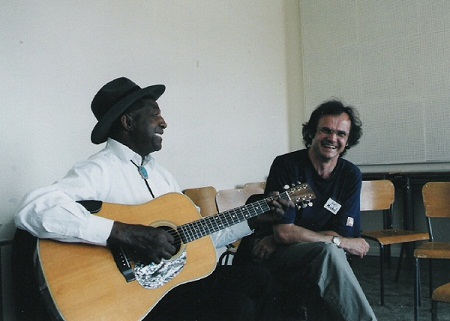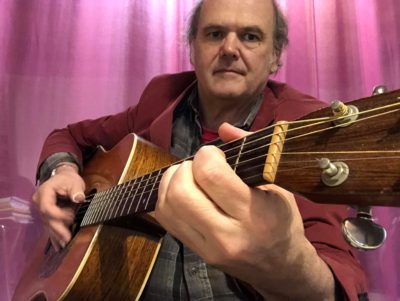by Frank Matheis 2021

Over in Tours, France, there is a passionate devotee to the acoustic blues who has spent nearly forty years as a guitar method teacher and transcriber. Even though he has recorded and performed, he has primarily made his mark on the acoustic genre as a teacher.
There are many points of view when it comes to the preservation and continuation of the traditional acoustic blues. One dominant perspective is that in order for the music to stay relevant and vibrant today it needs to evolve and renew itself. Another equally pervasive perspective is that preservation requires staying tightly close to the originals, virtually note for note, similar to the approach in Classical music. There is room and necessity for both, as all people learn and approach music differently. Both schools of thought have a point. People who can read music or work with tablatures often learn best by using sheet music and instructions, and in this sphere Lelong is a primary resource.
 Michel Lelong does not perform often, having a disdain for the small bar and pub venues where acoustic blues performers are typically booked. He prefers listening rooms where people are attentive to the performer. As a music transcriber, Lelong is a self-professed purist who stays tightly close to the original. He explained, “I am not a bluesman. I am Frenchman, and not a black American. Out of respect, I don’t claim to own it. I am foremost an interpreter of blues. I try to find the authenticity of the fingerings and the sound of great musicians. Mostly, I want to be a good teacher of guitar styles, including the fingerpicking of the East Coast acoustic blues. I believe that you must learn the songs as closely as possible to the way it was originally recorded, so that you can understand it. Then, you can find a path to making it your own style. Out of respect, I consider myself as an honest transmitter of tradition in these too often overused guitar techniques. I’d like to perform, but I play most of the time alone (or sometimes with my wife Florence).”
Michel Lelong does not perform often, having a disdain for the small bar and pub venues where acoustic blues performers are typically booked. He prefers listening rooms where people are attentive to the performer. As a music transcriber, Lelong is a self-professed purist who stays tightly close to the original. He explained, “I am not a bluesman. I am Frenchman, and not a black American. Out of respect, I don’t claim to own it. I am foremost an interpreter of blues. I try to find the authenticity of the fingerings and the sound of great musicians. Mostly, I want to be a good teacher of guitar styles, including the fingerpicking of the East Coast acoustic blues. I believe that you must learn the songs as closely as possible to the way it was originally recorded, so that you can understand it. Then, you can find a path to making it your own style. Out of respect, I consider myself as an honest transmitter of tradition in these too often overused guitar techniques. I’d like to perform, but I play most of the time alone (or sometimes with my wife Florence).”
Playing guitar well is one thing, but being able to deconstruct and annotate the music, to write out the score and present it in easy-to-understand terms requires a deeper knowledge of music theory. He has developed books and transcriptions, including a 65-page tab/music book about the Travis fingerpicking methods for Stefan Grossman. He also published instructional books with audiotapes about Jerry Reed and Chet Atkins for Grossman. The same year, Michel made his first country blues instructional video. In 1997, he even produced an instructional video of Celtic guitar techniques. In 1999, Lelong produced an instructional book La guitare blues acoustique teaching country blues guitar method (75 pages with CD showing ninety-nine examples and blues studies). This book is widely considered as one of the best of its kind in French.
His prolific list of transcriptions include: John Hurt, John Jackson, Big Bill Broonzy, Gary Davis, Johnny Shines, Lightnin’ Hopkins, Jerry Ricks, Brownie Mc Ghee, Mance Lipscomb, Memphis Minnie, Etta Baker, Tommy Johnson, Fred Mc Dowell, Skip James, Precious Bryant, Robert Petway, Robert Wilkins, William Moore, Willie Brown, etc.
He recorded his first CD in 1996 with some of the best French blues and bluegrass musicians. He has taught and performed at many of the music festivals and workshops throughout Europe and in the US, alongside Michael Roach, John Jackson, John Cephas & Phil Wiggins, Louisiana Red, John Miller, Michael Messer, Jerry Ricks, Paul Geremia, Bob Hall, and many other artists.
National Heritage Fellow and harmonica ace Phil Wiggins is a friend of Michel Lelong and says, “Michel is an accomplished and versatile finger style guitar player and a renowned teacher. Spending time with him and his wife Florence in their home and playing with them was a joy. Their personal hospitality and generosity informs them as people, musicians and teachers.”
